The Process
REDUCTION BLOCK PRINTS
The reduction block technique create an edition of prints that are printed from a single block of wood or lino; with each layer of colour added to the print more of the surface of the block is reduced using chisels to create the marks and from the image.
In contrast to the multi-coloured block method, where proofs can be created at any point and corrections made to the blocks, in the reduction method the artist can view and correct the work only as it develops progressively. Once a colour is printed and the next round of cutting away begins there is no going back. For this reason the method is often known as “suicide printing”.*
* taken from Lisa Studier’s ‘The Reduction Woodcut Technique’

THE PROCESS

First Joshua would cut his block, made from wooden board material or lino, to size. He then makes a jig to surround the block which holds it steady and in place so that the paper can then be placed over the block.
He then makes registration marks on the back edge of the paper running onto the surface of the jig, this means that the paper can be placed exactly in the same position for each layer.
Joshua would then sketch his image in mirrror-image on the surface of his block. This sketch then acts as a guide for cutting away the surface to create the print.
He uses a range of chisels to cut into the surface of the block, these marks form the image. The first cuts for the first layer of ink would often be any part that is to
remain white.
Now he mixes his lightest colour, which is always printed first. Each colour is normally a separate layer of ink, which is mixed on a large sheet of glass.
He then uses a roller to roll out the ink evenly on the glass and then rolls the colour over the surface of the block. The ink, when rolled, will only sit on the surface of the block, anywhere that has been cut away is not touched by
the ink.
Next, the block with the rolled out ink is placed in the jig that already has the first sheet of paper attached on
one edge.
The paper is then placed over the wet ink and the jig is then passed through the printing press, the first layer
is complete.
He then repeats this with all the sheets of paper for
his edition.
 All the ink, rollers and the surface of the block are now cleaned ready to start the next layer.
All the ink, rollers and the surface of the block are now cleaned ready to start the next layer.
Again, Joshua would cut away and remove more of the surface of the block for the next lightest colour to build up the image.
Colour separation of the image is an important part of
the process.
Now there is already a layer of colour on the paper; so to created the next required colour he must mix a third colour to achieve the correct colour for that layer.
With each layer he reduces the surface of the block more until the final layer and darkest colour.
It is often only at this stage when the darkest colour is printed that the image falls into place.
Since the surface of the block is cut away with each layer this means that the block is destroyed in the process. It is quite a labour of intensive and time consuming process.
Joshua makes only limited editions of a maximum of 10 prints.
MONOTYPE PRINTS
The word monotype literally means ‘one of a kind’ so each print created is unique.
The monotype processes a process where a solid block of ink is rolled out onto a featureless plate, Joshua normally uses a sheet of white masonite. The ink is then drawn into by wiping it away using either a finger covered with cloth, cotton bud or sponge.
The paper is held in place down the one edge using masking tape, this enables more than one layer of drawing to be printed on the same piece of paper.
The paper would be flipped aside and the surface cleaned in between the layers of ink.
Monotypes are known as the most painterly method amongst the print making techniques.


Selective rolling
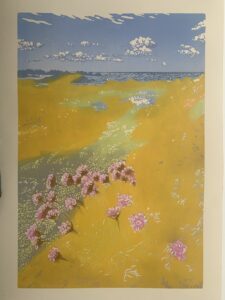
Selective rolling

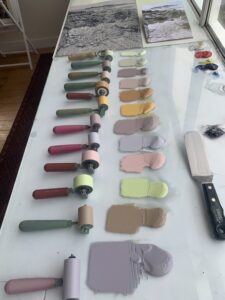
Inks ready…
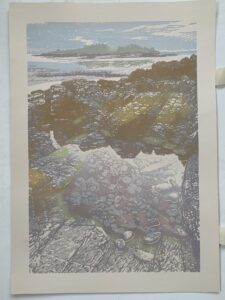
1st layer

2nd layer

3rd layer
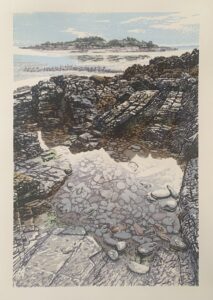
4th/final layer
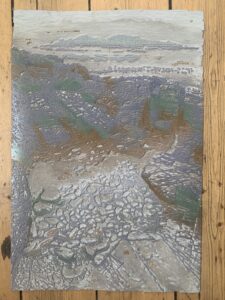
the lino






